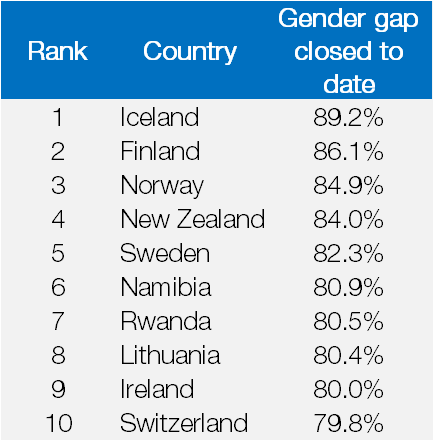For the 12th consecutive year, Iceland is once again the most gender-equal country in the world, according to the World Economic Forum’s Global Gender Gap Report 2021.
Finland came second place, followed by Norway, New Zealand, Sweden, Namibia, Rwanda, Lithuania, Ireland and Switzerland. See the top 10 below. The report also reveals that closing the global gender gap has increased by a generation from 99.5 years to 135.6 years, as reported.

TOP PERFORMERS
The five most improved countries in the overall index in 2021 are Lithuania, Serbia, Timor-Leste, Togo and United Arab Emirates; having narrowed their gender gaps by at least 4.4 percentage points or more. Timor-Leste and Togo also managed to close their economic gap by at least 17 full percentage points in the year. Three new countries were assessed for the first time this year. They include: Afghanistan (156th), Guyana (53rd) and Niger (138th).
Western Europe continues to be the best-performing region and has further improved, with 77.6% of its overall gender gap now closed. At this rate, it will take 52.1 years to close the gender gap. Six of the top 10 countries in the index are from this region; and 2021’s improvement is driven by the fact that 17 of the 20 countries in the region have at least marginally improved their performance.
MOST IMPROVED REGION
North America (76.4%), comprising Canada and the United States, is the most improved region, with an increase of almost 3.5%. As a result, it will take 61.5 years to close the gender gap here. A significant part of this year’s progress is related to improvements in the political gender gap, having narrowed from 18.4% to 33.4%.

Latin America and the Caribbean (72.1%) has seen 15 of the 25 countries in the region improving their overall scores. Belize, El Salvador and Suriname stand out for closing their gender gap by over 2.3 percentage points in one year. At this rate, it will take the region 68.9 years to close the gap.
Eastern Europe and Central Asia (71.2%), however, lags behind Western Europe; not only on the proportion closed but also on the pace of progress. As such, the estimated time to close the gender gap is 134.7 years, more than twice that of Western Europe (52.1 years). The regional average also masks large disparities between countries on closing the political gender gap.
While Serbia, Lithuania, Albania and Latvia have closed at least 30% of this gap; the Russian Federation and Azerbaijan have closed less than 10% of their gaps.
SLOW PROGRESS NOTED IN ASIA
East Asia and the Pacific (68.9%) is one of the three most-improved regions, having narrowed its gender gaps on three of the four sub-indexes (economic, education and health). However, it regressed on the political gender gap. On its current trajectory, it will take another 165.1 years to completely close the gap; almost 30 years longer than the global average.

Sub-Saharan Africa (67.2%) has made slow progress, such that it will take 121.7 years to close the gender gap. More than half of the countries in the region (20 out of 34) made progress towards gender parity in the past year. However, only Namibia and Rwanda have closed at least 80% of their gaps.
POOR PERFORMANCE
South Asia is the second-lowest performer, with 62.3% of its overall gender gap closed and progress going into reverse in the past year. A decline of 3.8 percentage points means that it is expected to take 195.4 years to close the gender gap. With its large population and poor score, India’s performance has a substantial impact on the region’s overall score.
The Middle East and North Africa region continues to have the largest gender gap (39.1%) to be closed. Despite a slight improvement (+0.5 percentage points), progress is slow, and it will take 142.4 years to close the gender gap, due in large part to the wide economic gender gap, with just 31% of women taking part in the labour force. Click here to read the full report.







































